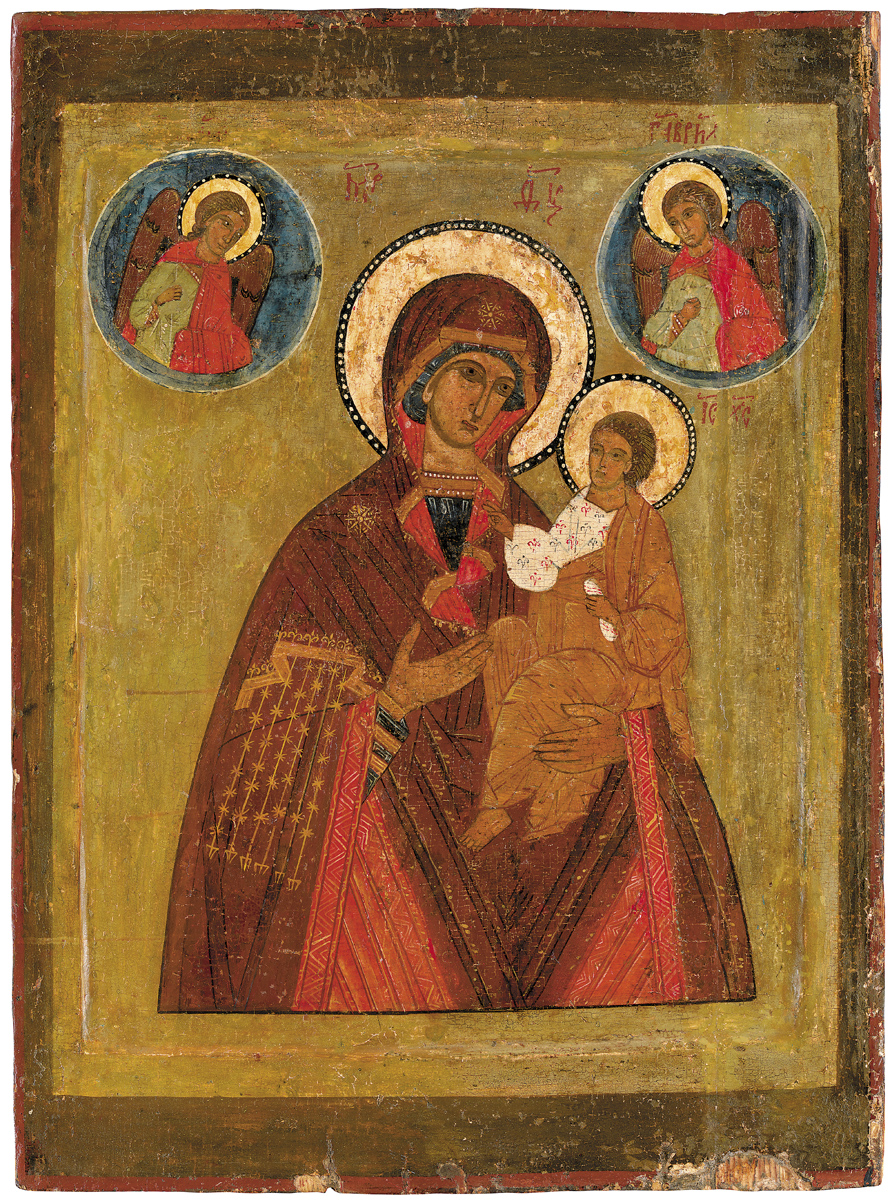MacDougall's Russian Art Auctions 1-2 Dec 2010
1 December 2010

626. AN IMPORTANT ICON OF THE MOTHER OF GOD HODEGETRIA WITH THE ARCHANGELS MICHAEL AND GABRIEL
NORTHERN RUSSIA, CIRCA 1600
79 by 58.4 cm
100,000-150,000 GBP
The icon represents a rare version of the Hodegetria Mother of God. It is based on the “Georgian” Hodegetria Mother of God (which is itself a mirror-image version of the “Jerusalem Mother of God”). The artist has reproduced the special features of this type of icon: the Christ child is posed to turn towards the Virgin who holds him on her left arm, his right foot is crossed under his left leg; his right hand is raised in a blessing gesture and he holds a scroll in his left. His himation is draped over one shoulder, revealing his bright, decorated chiton; the head of the Virgin is inclined towards the Infant.
One of the most typical characteristics of the Jerusalem and Georgian types of Hodegetria is the particular way of depicting the folds of the Virgin’s maphorion. The bright red lining is shown as wide, symmetrical pleats on the reverse of the garment Mother of God icons of this type were widespread in 16th century Rus (including the most revered, holy relics of Novgorod), but they were not known as “Georgian” until a celebrated miracle-working icon from Georgia was brought via Persia in 1625 to the Chernogorsk monastery in the Archangelsk diocese.
At the same time however, certain details of our icon are reminiscent of the Hodegetria Mother of God of Smolensk. The chiton of the infant Christ is painted in the same manner as it is shown worn over the right shoulder rather than the left, as in the Georgian icon. Neither does the himation hang as low or reveal the girdle, which like the clavus on the sleeve are interpreted in the Georgian icon as an appurtenance of priestly vestment. It may be the influence of the Smolensk image, where the seated Infant is strictly full face, that explains why, in our icon, Christ is not turned as much towards the Virgin (in the Georgian Mother of God, he is half-turned). Furthermore, it is particularly in the Smolensk icons of the Mother of God that we find images contained in circles in the upper corners of the icon, depicting the archangels Michael and Gabriel.
A striking peculiarity of our icon is the depiction of the Mother of God as a significantly larger figure than is generally the case with Hodegetria images. To judge by the ‘unskilful’ use of straight, parallel lines to render the folds of the Virgin’s maphorion far below the traditionally bottom edge of the icon, and the professional positioning of the garment-folds above this line in accordance with the traditional exemplum, we may conclude that the artist’s creative approach to producing this image of the Mother of God used two different types of Hodegetria to generate a balanced overall composition of the Virgin and Child and archangels. Our attention is also drawn to the fact that the faces of the archangels in the icon are turned towards the Virgin (whereas in the Smolensk icon they, like the Infant, are full-face portrayals). This compositional nuance also lends a special spiritual tension to the icon.
The iconographic treatment of this image is a great rarity in Old Russian painting. Creative use of the canons, which allowed the artist to devise an exceptionally expressive image of the Mother of God, and a strictly limited palette of red, brown, dark blue, green and gold, with red singled out for its symbolism, make this icon a unique, landmark artefact of Russian icon painting.
Notes on symbols:
* Indicates 5% Import Duty Charge applies.
Ω Indicates 20% Import Duty Charge applies.
§ Indicates Artist's Resale Right applies.
† Indicates Standard VAT scheme applies, and the rate of 20% VAT will be charged on both hammer price and premium.